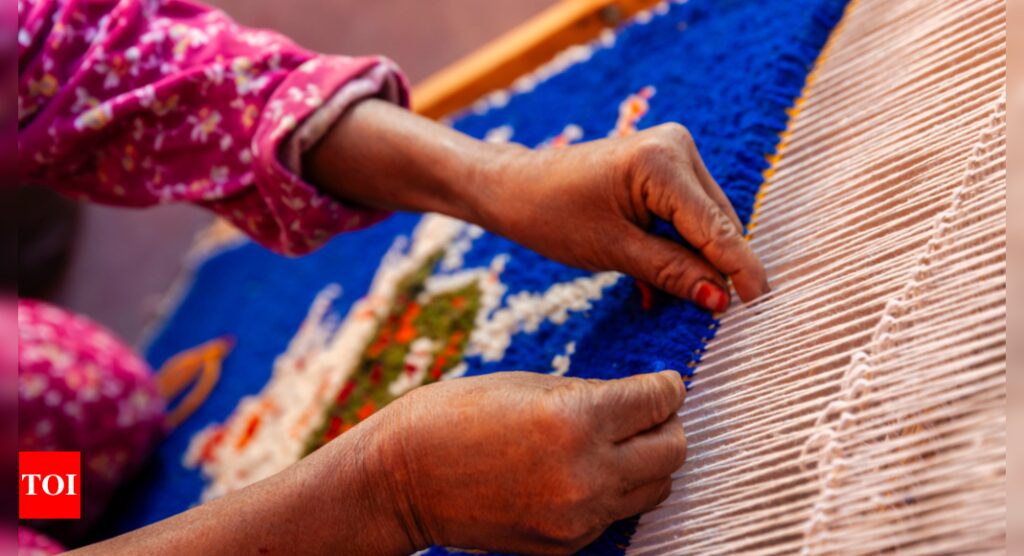Why we need to celebrate Handlooms once again

The soft touch of handloom fabric, its graceful drape, breathability, and a spectrum of colors from soothing pastels to vibrant hues evoke a sense of joy that resonates deeply with womankind. Who can resist the allure of a new handloom saree—deeply entwined with tradition, festivals, and celebrations, once among the rare moments when women could indulge in the apparel of their dreams? Handloom holds a cherished place in Indian culture, being the original fabric of the land.
Handloom is significant also because it plays a crucial role in promoting women’s empowerment, with over 70% of its weavers and allied workers being women.Rooted in sustainability, handloom production is eco-friendly, requiring minimal capital and power while offering the flexibility to innovate and adapt to evolving fashion trends and customer preferences.. India is the largest producer of handloom textiles in the world, with handlooms contributing around 15% of all the fabrics produced in the country. Indian handlooms have a huge market across the world, especially in Europe and the United States.

(Image Credits: iStock)
GI Tags
Several handloom products in India are internationally acclaimed and have been given a Geographical Indication tag, celebrating their unique craftsmanship and regional dominance:
Gujarat: Tangaliya and Kachchh Shawls, Patola
Jammu & Kashmir: Pashmina and Kani Shawl
Himachal Pradesh: Kullu and Kinnauri Shawl
Kerala: Balaramapuram Sarees, Kasaragod Sarees, Kuthampully Sarees, Chendamangalam and Kuthampully Dhotis
Andhra Pradesh: Uppada Jamdani Sarees, Venkatagiri Sarees, Mangalagiri Sarees, Dharmavaram Pattu Sarees, and Paavadas
Karnataka: Ilkal Sarees, Molakalmuru Sarees, Udupi Sarees, and Mysore Silk
Madhya Pradesh: Chanderi and Maheshwari Sarees
Maharashtra: Solapur Chaddar, Paithani Sarees, Solapur Terry Towel, Karvath Kati Tussar Sarees
Manipur: Shaphee Lanphee, Wangkhei Phee, Moirang Phee
Odisha: Kotpad Handloom, Ikat, Khandua Saree, Gopalpur Tussar, Dhalapathar Parda, Sambalpuri Saree, Bomkai Saree, Habaspuri Saree, Berhampur Patta Saree
Bihar: Bhagalpur Silk
Tamil Nadu: Kancheepuram Silk, Bhavani Jamakkalam, Madurai Sungudi, Arani Silk, Kovai Kora Sarees, Salem Silk
Assam: Muga Silk
Telangana: Pochampally Ikat, Gadwal Sarees, Siddipet Gollabama, Narayanpet Handloom Sarees
Uttar Pradesh: Banarasi Saree, Mirzapur Handmade Dari
West Bengal: Santipur Saree, Baluchari Saree, Dhaniakhali Saree
Chhattisgarh: Champa Silk Saree, Kota Doria
Rajasthan: Kota Doria
Nagaland: Chakhesang Shawls

(Image Credits: iStock)
What is a handloom??
A loom is an apparatus for making fabric by weaving yarn or thread. A handloom, however, does not use electricity but relies on manual energy. There are two main types of handlooms—pit looms and frame looms—which are typically found in a weaver’s home. The loom transforms cotton thread into fabric.
Why is walking on the ramp called a ‘Catwalk’?
Is handloom the same as Khadi??
To understand this, we must differentiate between the yarn types—hand-spun and machine-spun. When hand-spun yarn is woven into cloth on a handloom, it is called Khadi. When machine-spun yarn is woven on a handloom, the result is handloom fabric.

(Image Credits: iStock)
What makes handloom special…and expensive
“Handmade and hand-loomed fabrics are more expensive and special due to the unique artistry involved in creating them. The art of making them has been handed down from Each type of fabric offers distinct benefits, making them valuable additions to any wardrobe. For example, at Woodloom, we celebrate this diversity by offering a wide range that combines traditional techniques with contemporary designs. Whether you are looking for the breathability of cotton, the luxury of silk, the warmth of wool, the coolness of linen, the durability of synthetics, or the versatility of blended fabrics, handloom fabrics have something for everyone”, says Tushar Joshi, Founder of Utkarsh Vastukaran.
According to Ekta Verma, Founder of ETOS Designs, “Since cost is the main component in every market space, handlooms typically turn out to be more expensive due to manual labor and time-intensive production processes. On the contrary, cotton is generally cheaper, especially for mass-produced cotton fabrics. Handloom is traditional artistry in every thread. We must not forget that by supporting handloom, conscious consumers can celebrate India’s pre-independence rich cultural heritage while empowering local artisans and communities.”

(Image Credits: iStock)
Government support
Handlooms have a historical significance in India due to the association of Khadi with Mahatma Gandhi and the freedom movement. The wheel from the charkha or the “loom” adorns our flag.
Zara all set to launch its second-hand platform
The Government of India has introduced various schemes to support the handloom sector, such as the National Handloom Development Programme (NHDP), Weavers’ Mudra Scheme, and Handloom Mark to certify the authenticity of handloom products. Khadi Gram Udiyogs are also supported. National Handloom Day is celebrated on August 7th to recognize the importance of this sector and promote indigenous products.

(Image Credits: iStock)
The need to switch to handlooms
According to designer Lalit Dalmia, “The handloom, in my opinion, is a living, breathing entity that connects us with our ancestors. As designers, it is our duty to uplift this craft to match the changing times.”
-The most important reason to switch to handlooms is sustainability. They have a low carbon footprint and require little or no energy. Handlooms are made from natural fibers like cotton, silk, wool, and jute, which are biodegradable and have a lesser environmental impact compared to synthetic fibers. Handloom fabrics require less water and fewer chemicals for production and dyeing, especially when traditional, natural dyes are used. This makes them more environmentally sustainable than mass-produced textiles.

(Image Credits: iStock)
-Secondly, by purchasing handloom products, one can directly support local weavers and artisans, many of whom belong to economically disadvantaged communities.
-By choosing handloom, one can also help preserve these traditional crafts, ensuring they are not lost to the growing dominance of machine-made textiles.
-They are also healthier than artificial fabrics. Handloom fabrics, especially those made from natural fibers, are less likely to cause skin irritations or allergies compared to synthetic materials that may contain harmful chemicals or dyes.
Tracing the story of the beloved Kashida embroidery through the threads of time
-Several varieties of handlooms are also durable since they are crafted from natural fibers, they tend to be more durable and can last for years.
-Like old wine they may even get better with age and are said to develop a unique texture over time. For example it is said about Bhagalpuri Khaddars and Tussar that the more you wash them, the shinier they become.

(Image Credits: iStock)
How to maintain handloom
Handlooms are handmade, and due to manual weaving, the threads may have gaps that make the fabric breathable but slightly delicate. Thus, handlooms require careful handling:

(Image Credits: iStock)
Follow care instructions on the labels:
- Wash separately in cold water, as natural colors like indigo may not always be colorfast.
- Avoid harsh chemicals and machine washing.
- Dry in the shade to preserve the fabric’s color.








